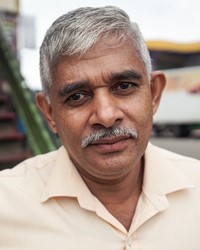Sinhalese in Malaysia

Photo Source:
Copyrighted © 2026
The Road Provides - Shutterstock All rights reserved. Used with permission |
Send Joshua Project a map of this people group.
|
| People Name: | Sinhalese |
| Country: | Malaysia |
| 10/40 Window: | Yes |
| Population: | 4,900 |
| World Population: | 714,500 |
| Primary Language: | Sinhala |
| Primary Religion: | Buddhism |
| Christian Adherents: | 2.00 % |
| Evangelicals: | 0.10 % |
| Scripture: | Complete Bible |
| Ministry Resources: | Yes |
| Jesus Film: | Yes |
| Audio Recordings: | Yes |
| People Cluster: | South Asia Buddhist |
| Affinity Bloc: | South Asian Peoples |
| Progress Level: |
|
Introduction / History
Singhalese are believed to be of Aryan descent. They migrated from India (Bengal, Odisha, and Gujarat) to Sri Lanka as early as the 6th century B.C., where they were known as Singhalese. The Singhalese King, court, and people converted to Indian Buddhism in the 2nd century B.C.
Singhalese, mainly jewel merchants, began migrating to Malaysia as early as 1890. Many of these early Singhalese immigrants returned to Sri Lanka after earning enough money. The Singhalese consider themselves Indians. There are no distinct physical features that set the Singhalese apart from other Indians.
What Are Their Lives Like?
In the early 20th century, Singhalese youth migrated to Malaysia with intentions of settling down permanently. Unlike the Sri Lankan Tamil, these Singhalese youth had no family or friends already settled in Malaysia to assist them. However, with the growth of Malaysia's rubber plantations and tin industries, there was an increasing demand for railroad transport providing a major source of employment to migrants from Sri Lanka. The Singhalese primarily settled in the Kuala Lumpur and Taiping where they work as drivers, security guards, bus ticket inspectors, and later on as station masters. Those with an excellent command of English work as government employees. On the rubber plantations, they held positions such as conductors, bookkeepers, clerks, and hospital assistants. There were a few Singhalese craftsmen and surveyors.
With the number of mixed marriages with Indians and other Malaysian communities, the number of Singhalese continues to decrease in Malaysia. The majority of Singhalese prefer to use English and Malay despite efforts of the older generation in trying to maintain their mother tongue. Western clothing is becoming the norm among the Singhalese in Malaysia, with the exception of ceremonial functions. Many Singhalese practices such as burial rites have strong Indian influences.
What Are Their Beliefs?
The majority of Singhalese in Malaysia are Theravada Buddhist and the temple is the focal point of their activities. Minorities of Christian Singhalese maintain their ties through the church. Besides the religious Wesak day (a Buddhist celebration of Buddha's enlightenment), the Singhalese Buddhist community also celebrates the New Year usually on 14th April. New Year's Day begins with lighting a lamp and placing it in a prominent position in the house and it is believed to drive away evil spirits. Certain foods are required, and it is believed that eating these foods on an auspicious day will bring one good fortune throughout the year. This custom is still practiced despite disbelief among people in their community today.
What Are Their Needs?
Though they are proud of their heritage, this small Singhalese community continues to struggle to preserve its cultural distinction as they blend more with the mainstream Malaysian society.
Prayer Points
Pray that local believers will relate and respond to the unique needs of the Singhalese.
As they integrate into society, pray that they will be open to Indian believers and see the Truth in their lives.
Pray for the Holy Spirit to penetrate Sinhalese families in Malaysia.
Pray that soon Sinhalese disciples will make more disciples.